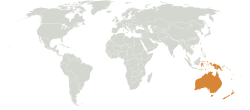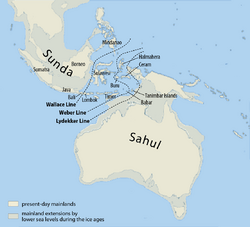Australasian ecozone facts for kids


The Australasian zone is a special natural area. It is also called an ecozone. This zone includes the lands of Australia, New Guinea, and many nearby islands. It is known for its very unique plants and animals.
The northern edge of this ecozone is called the Wallace Line. This imaginary line helps show where the animals of Asia stop and the animals of Australasia begin.
Contents
Where is the Australasian Ecozone?
This ecozone covers a large area. It includes the entire continent of Australia. It also includes the big island of New Guinea. This island is split into Papua New Guinea and the Indonesian province of Papua.
Islands of the Australasian Zone
Many smaller islands are part of this zone. These include the eastern parts of Indonesia. For example, the island of Sulawesi is in this zone. The Moluccan islands, like Maluku and North Maluku, are also included.
Other islands like Lombok, Sumbawa, Sumba, Flores, and Timor are part of this zone. These are often called the Lesser Sundas.
The ecozone also reaches into the Pacific Ocean. It includes island groups such as the Bismarck Archipelago, Vanuatu, the Solomon Islands, and New Caledonia. New Zealand and its surrounding islands are also a special part of this zone. The rest of Indonesia belongs to a different ecozone called Indomalaya.
Why is Australasia's Wildlife Unique?
The Australasian ecozone has very special plants and animals. This is because of its long history. Millions of years ago, the land that is now Australia and New Guinea was connected to Antarctica. They were part of a huge supercontinent called Gondwana.
Over time, the land broke away and moved north. This long separation meant that the plants and animals here developed on their own. They were not mixed with species from other parts of the world.
Amazing Mammals of Australasia
One of the most interesting things about this ecozone is its mammals. It is home to the only two living monotremes. Monotremes are very rare mammals that lay eggs, like the platypus and echidna.
Almost all other native mammals in Australasia are marsupials. Marsupials are mammals that carry their babies in a pouch. Kangaroos, koalas, and wallabies are all marsupials. Before humans arrived, there were no native eutherian mammals (placental mammals) in Australia.
How Other Animals Arrived
Evidence from fossils shows that some placental mammals did arrive later. Around 15 million years ago, bats started appearing in the fossil record. Then, 5 to 10 million years ago, rodents arrived. About 1 million years ago, rats also made their way to Australia.
More recently, humans brought new animals. Several thousand years ago, people brought the dingo to Australia. About 200 years ago, many more species were introduced by humans.
The animals of New Zealand and the Pacific islands are a bit different. Many of the animals from the Indomalayan ecozone did not reach these islands.
The Wallace Line
The famous scientist Alfred Russel Wallace discovered the dividing line for this ecozone. This line, now called the Wallace Line, separates the Australasian ecozone from the rest of the world. It runs between the islands of Lombok (which is in Australasia) and Bali (which is in Indomalaya).
See Also

